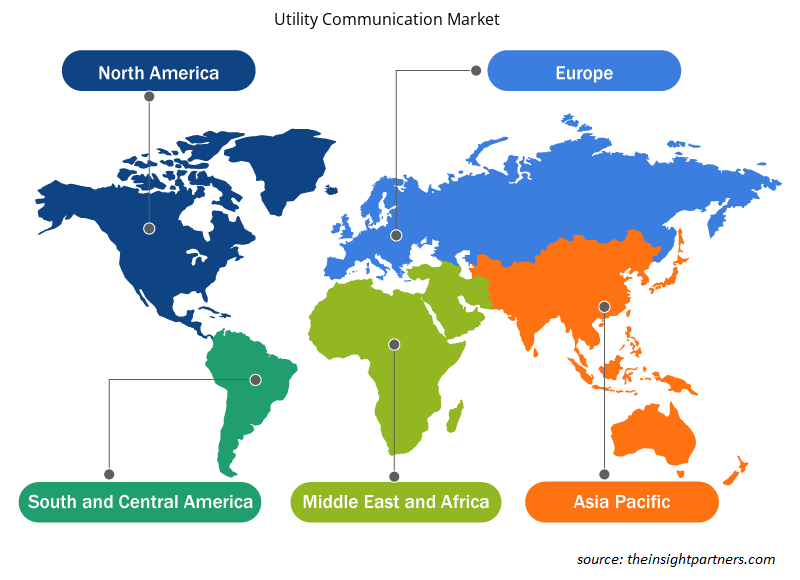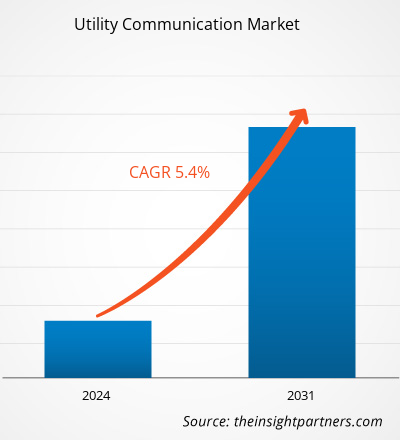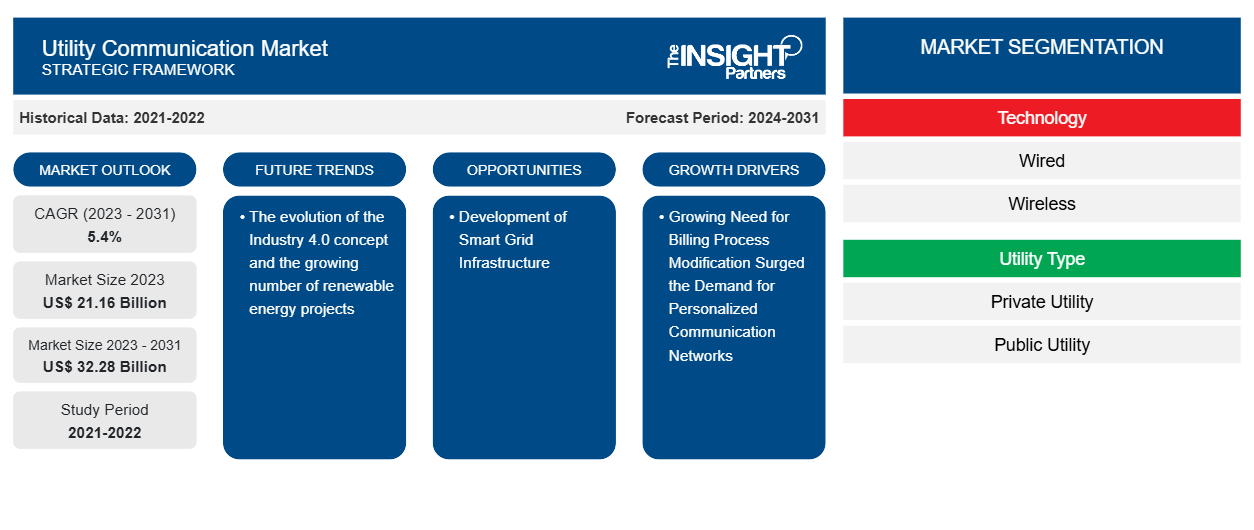من المتوقع أن يصل حجم سوق اتصالات المرافق إلى 32.28 مليار دولار أمريكي بحلول عام 2031 من 21.16 مليار دولار أمريكي في عام 2023. ومن المتوقع أن يسجل السوق معدل نمو سنوي مركب بنسبة 5.4٪ في الفترة 2023-2031. ومن المرجح أن يظل تطور مفهوم الصناعة 4.0 والعدد المتزايد من مشاريع الطاقة المتجددة من الاتجاهات الرئيسية لسوق اتصالات المرافق.
تحليل سوق الاتصالات الخدمية
ينمو سوق الاتصالات الخدمية بوتيرة سريعة بسبب الحاجة المتزايدة لتعديل عملية الفوترة، مما أدى إلى زيادة الطلب على شبكات الاتصالات المخصصة والطلب المتزايد على موارد الطاقة الموزعة. يتوسع السوق بشكل مطرد، مدفوعًا بالمبادرات الحكومية المواتية والاستثمارات لتعزيز تطوير البنية التحتية للطاقة. علاوة على ذلك، فإن تطوير البنية التحتية للشبكة الذكية والاعتماد المتزايد على الأنظمة المتقدمة تقنيًا والمتكاملة مع إنترنت الأشياء والذكاء الاصطناعي يوفر فرصًا مربحة لنمو السوق.
نظرة عامة على سوق الاتصالات الخدمية
اتصالات المرافق هي أنظمة تضمن نقلًا أكثر موثوقية وأمانًا وأمانًا للبيانات والفيديو والصوت عبر شبكات WAN وLAN. يوفر نظام الاتصالات هذا للمستخدمين فوائد التثبيت السهل في المواقع الخطرة. يعمل نظام اتصالات المرافق باستخدام شبكات عديدة، بما في ذلك مراقبة الفيديو والشبكة الذكية ونظام التحكم الإشرافي واكتساب البيانات (SADA) والاتصال القائم على إيثرنت. علاوة على ذلك، فإن الطلب المتزايد على أنظمة الاتصالات السلكية واللاسلكية من قبل المرافق لمراقبة استهلاك الطاقة وتوزيعها يعزز السوق خلال فترة التنبؤ.
قم بتخصيص هذا التقرير ليناسب متطلباتك
ستحصل على تخصيص لأي تقرير - مجانًا - بما في ذلك أجزاء من هذا التقرير، أو تحليل على مستوى الدولة، وحزمة بيانات Excel، بالإضافة إلى الاستفادة من العروض والخصومات الرائعة للشركات الناشئة والجامعات
-
احصل على أهم اتجاهات السوق الرئيسية لهذا التقرير.ستتضمن هذه العينة المجانية تحليلاً للبيانات، بدءًا من اتجاهات السوق وحتى التقديرات والتوقعات.
رؤى إقليمية حول سوق الاتصالات الخدمية
لقد قام المحللون في Insight Partners بشرح الاتجاهات والعوامل الإقليمية المؤثرة على سوق اتصالات المرافق طوال فترة التوقعات بشكل شامل. يناقش هذا القسم أيضًا قطاعات سوق اتصالات المرافق والجغرافيا في جميع أنحاء أمريكا الشمالية وأوروبا ومنطقة آسيا والمحيط الهادئ والشرق الأوسط وأفريقيا وأمريكا الجنوبية والوسطى.

- احصل على البيانات الإقليمية المحددة لسوق الاتصالات الخدمية
نطاق تقرير سوق الاتصالات الخدمية
| سمة التقرير | تفاصيل |
|---|---|
| حجم السوق في عام 2023 | 21.16 مليار دولار أمريكي |
| حجم السوق بحلول عام 2031 | 32.28 مليار دولار أمريكي |
| معدل النمو السنوي المركب العالمي (2023 - 2031) | 5.4% |
| البيانات التاريخية | 2021-2022 |
| فترة التنبؤ | 2024-2031 |
| القطاعات المغطاة |
حسب التكنولوجيا
|
| المناطق والدول المغطاة |
أمريكا الشمالية
|
| قادة السوق وملفات تعريف الشركات الرئيسية |
|
كثافة اللاعبين في السوق: فهم تأثيرها على ديناميكيات الأعمال
يشهد سوق الاتصالات الخدمية نموًا سريعًا، مدفوعًا بالطلب المتزايد من المستخدم النهائي بسبب عوامل مثل تفضيلات المستهلكين المتطورة والتقدم التكنولوجي والوعي المتزايد بفوائد المنتج. ومع ارتفاع الطلب، تعمل الشركات على توسيع عروضها والابتكار لتلبية احتياجات المستهلكين والاستفادة من الاتجاهات الناشئة، مما يؤدي إلى زيادة نمو السوق.
تشير كثافة اللاعبين في السوق إلى توزيع الشركات أو المؤسسات العاملة في سوق أو صناعة معينة. وهي تشير إلى عدد المنافسين (اللاعبين في السوق) الموجودين في مساحة سوق معينة نسبة إلى حجمها أو قيمتها السوقية الإجمالية.
الشركات الرئيسية العاملة في سوق الاتصالات الخدمية هي:
- شركة أيه بي بي المحدودة
- فوجيتسو المحدودة
- شركة جنرال الكتريك
- شركة هونيويل الدولية
- شركة أوميكرون للإلكترونيات المحدودة
- روكويل أوتوميشن
إخلاء المسؤولية : الشركات المذكورة أعلاه ليست مرتبة بأي ترتيب معين.

- احصل على نظرة عامة على أهم اللاعبين الرئيسيين في سوق الاتصالات الخدمية
- التحليل التاريخي (سنتان)، سنة الأساس، التوقعات (7 سنوات) مع معدل النمو السنوي المركب
- تحليل PEST و SWOT
- حجم السوق والقيمة / الحجم - عالمي، إقليمي، بلد
- الصناعة والمنافسة
- مجموعة بيانات إكسل
التقارير الحديثة
شهادات العملاء
سبب الشراء
- اتخاذ قرارات مدروسة
- فهم ديناميكيات السوق
- تحليل المنافسة
- رؤى العملاء
- توقعات السوق
- تخفيف المخاطر
- التخطيط الاستراتيجي
- مبررات الاستثمار
- تحديد الأسواق الناشئة
- تحسين استراتيجيات التسويق
- تعزيز الكفاءة التشغيلية
- مواكبة التوجهات التنظيمية























 احصل على عينة مجانية ل - سوق اتصالات المرافق
احصل على عينة مجانية ل - سوق اتصالات المرافق